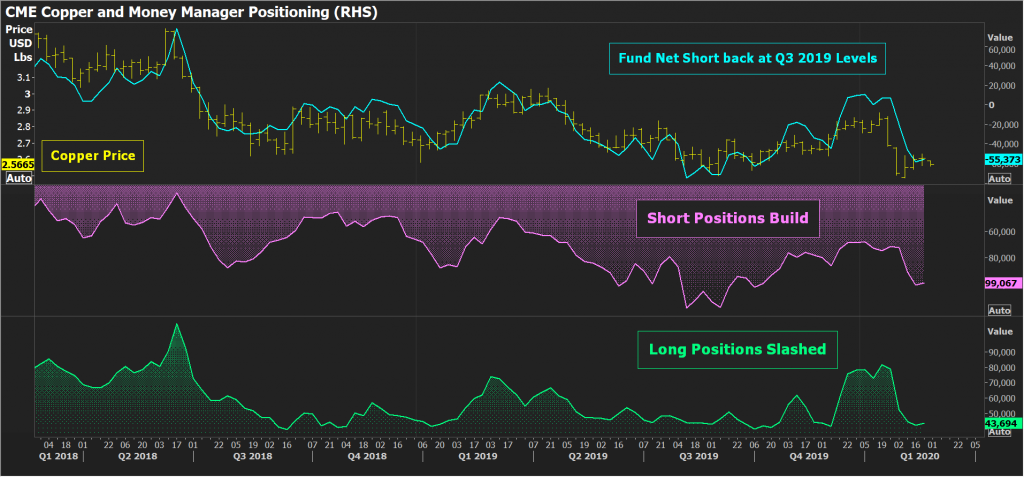Funds sell copper as coronavirus hits physical supply chains

Funds have given up on their early-year hopes for higher copper prices.
Investors have turned bearish on the CME copper contract , slashing long positions and putting on fresh bets for lower prices.
The net money manager short is now back at levels last seen in the third quarter of 2019, when market sentiment hit a “trade war” trough.
The deadly coronavirus has frozen the expected Chinese manufacturing recovery story and is now showing signs of spreading to South Korea, another industrial powerhouse.
While equity markets have been taking a more sanguine view of the medium-term economic impact of the virus, copper is starting to price in the multiple short-term impacts on the physical supply chain.
This is not just a demand story, however, since logistics problems are also affecting China’s copper producers. That adds another layer of uncertainty to an already complex mix.
Funds turn bearish again
Money managers were net short of CME copper to the tune of 55,373 contracts as of Feb. 18, according to the latest Commitments of Traders report.
Positioning was little changed week on week but the turnaround since the start of the year has been stark.
The money men shifted to net long in December as China’s stuttering manufacturing engine showed signs of recovery.

However, those long positions have been slashed from over 81,511 contracts in the middle of January to a current 43,694. Fresh short positions have accumulated over the same time frame with money managers now holding almost 100,000 contracts of bear bets.
The collective negativity is the worst since peak trade-war blues in the third quarter of last year.
Hedge fund managers appear more focused on the current state of the physical copper market than the promise of a sharp economic rebound in China when Beijing unleashes the investment taps.
But then, as analysts at Goldman Sachs point out, the size of the short-term disruption is “unprecedented”. (“The impact of 2019-nCoV on industrial metals”, Feb. 14, 2020)
Quarantining and restrictions on movement at a time when migrant workers would normally be expected to be returning to work mean the number of “missing work days” in China is roughly “equivalent to the entire U.S. workforce taking an unplanned break for two months.”
Pricing disruption
Goldman has just cut its three, six and 12-month copper price forecasts from $6,300, $6,500 and $7,000 per tonne to $5,900, $6,200 and $6,500 respectively.
The investment bank argues that the virus represents “a meaningful demand shock for copper” and is modelling a demand decline of 18% year on year in the first quarter.
Citi estimates that 500,000 to 700,000 tonnes of industrial short positions could be seen, pressuring prices further
The promise of future stimulus risks blinding investors to “the physical realities of the disruption today,” (“Promise of stimulus builds downside risk to commodities”, Feb. 21, 2020).
Analysts at Citi agree.
“Our base case is for physical market weakness to dominate futures buying over the coming weeks,” it said. (“Metals Weekly,” Feb. 18, 2020).
“The Chinese demand recovery is likely to be more gradual than many expect, since more than three-quarters of migrant workers are yet to return post (Chinese New Year), and half of these are not expected to return until March,” the bank adds.
A big short-term hit to copper demand will translate into surging inventories, which will in turn require hedge short positions to be built on the CME and London Metal Exchange (LME).
Citi estimates that 500,000 to 700,000 tonnes of industrial short positions could be seen, pressuring prices further.
It’s possible a massive counter-build in speculative positioning could compensate but it would require a sharp shift in the coronavirus news-flow such as a clinical drug breakthrough.
Signs of surplus metal are already starting to show in China.
Stocks of copper registered with the Shanghai Futures Exchange (ShFE) have ballooned from 124,000 tonnes at the start of January to 298,600 tonnes.
Chinese copper inventory always rises over the new year holiday period but this year’s 175,000-tonne surge is already outpacing the peak January-March build of 143,000 tonnes in 2019 and 156,000 tonnes in 2018.
Inventories at bonded warehouses in Shanghai are also thought to be rising.
The pronounced contango across the front part of the ShFE copper futures curve suggests the local market is expecting more surplus metal to appear in the coming weeks.
Smelter pressures
Mitigating some of the demand shock may be lower Chinese copper production as smelters face their own physical supply-chain headaches.
Smelters are struggling both to receive enough mined concentrate to keep running and to sell the sulphuric acid they generate as a by-product of making copper.
“There is a general loss of efficiency across the concentrates supply chain from ports to smelters due to restrictions on movement and extension of holidays for couriers, customs brokers, customs, etc.,” according to research house Wood Mackenzie.
It notes that multiple Chinese smelters are experiencing concentrates delivery delays. (“Coronavirus and its impact on the copper market,” Feb. 6, 2020).
The acid market in China, meanwhile, has partially ground to a halt.
Woodmac estimates that Hubei province, the epicentre of the virus outbreak, is the largest phosphate fertilizer producer in China and accounts for around 20% of the country’s sulphuric acid consumption.
Copper smelters have only limited acid storage capacity, threatening their ability to maintain production.
One producer, Guangxi Nanguo Copper with production capacity of 300,000 tonnes per year, has already declared partial force majeure on concentrate deliveries as it adjusts run-rates.
Others are expected to follow by bringing forward planned maintenance downtime.
Uncertainty and volatility
Lower domestic copper production and the likely push-back of smelter expansion projects offer only a partial offset to the demand shock unfolding in China.
They do, however, inject yet more uncertainty and potential price volatility into an already complex equation.
So too does the apparent spread of the virus to South Korea and northern Italy, each of which poses another set of physical supply-chain problems.
The current “high degree of uncertainty about the size and duration of the disruptions (will) mean industrial metals are likely to face significant headwinds and rising volatility in coming months,” according to Goldman Sachs.
Fund managers appear to agree.
(By Andy Home; Editing by David Evans)
More News
First Quantum’s Cobre Panama mine ready to suspend arbitration
Panama government will allow the export of 120,000 metric tons of copper concentrate that has been stuck in the shuttered mine for over two years and allow restart of the power plant used to run the mine.
March 14, 2025 | 12:31 pm
Trump-driven turbulence draws new investors into gold
Analysts say the policy upheaval has begun to tempt US investors into gold ETFs.
March 14, 2025 | 11:27 am
{{ commodity.name }}
{{ post.title }}
{{ post.excerpt }}
{{ post.date }}



Comments